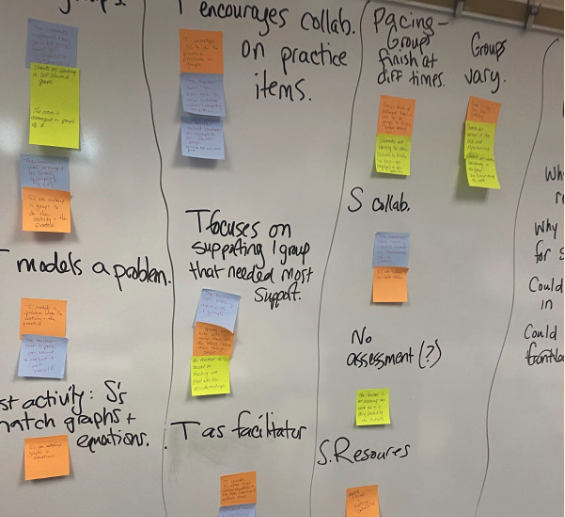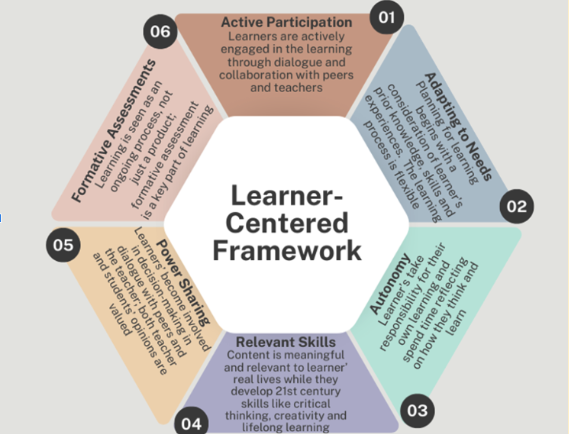On Wednesday, February 5, the PL Network had its third Deep Dive at Mount Hope High School (MHHS) in the Bristol-Warren Regional School District (BWRSD). MHHS Associate Principal Wayne Lima led the group, along with BWRSD PL network members Assistant Superintendent Diane Sanna, Literacy Coordinator Mary Cabral, and Math Coordinator Chris Slater. At MHHS, the group continued on the same themes explored in previous deep dives in Narragansett and Woonsocket, focusing on curriculum implementation and instructional practice through discussion with leaders and observations of 9th and 10th grade math classrooms. The district’s overarching PL strategy is to “use curriculum to advance the instructional vision.”

To start the day, Wayne Lima oriented visitors to the vision for instruction, the Learner-Centered Framework, and instructional leaders’ strategy for supporting teacher learning at MHHS. Following classroom observations, using a tool aligned to the Framework, visitors shared evidence from classrooms, discussed the progress the school is making toward its PL goals, and suggested potential next steps for PL leaders.
PL Network members who joined the Deep Dive also continued to develop their own individual learning and the group’s collective understanding of PL trends in the state. They noted ongoing topics of discussion in PL network conversations: the goal and the challenge of instruction that centers student thinking and conceptual understanding; and the importance of fostering a positive culture of adult learning. These threads illustrate the common experiences and the collective opportunities for instructional improvement through CBPL in RI.

What we learned about CBPL in Bristol-Warren:
- CBPL changes practice at both the individual teacher and the team level. PL leaders in Bristol-Warren attend to both processes with aligned but differentiated strategies.
- Department chairs lead weekly hour-long meetings with each teacher team during common planning time (CPT). The Associate Principal provides an agenda structure that department chairs use to guide teachers’ planning of how they will implement prioritized components of the Learner-Centered Framework in their teaching with the curriculum. As in Narragansett, CPT is a key precondition of BW’s PL strategy.
- Regular walk-throughs provide data that inform the PL leadership of both school administrators and department chairs. Department chairs are the owners of the walk-through data tools, ensuring that they have agency to lead instructional change with teachers in their departments. When individual teachers need support, department chairs, colleagues that teachers feel comfortable with, provide it.
- MHHS’s strategy for distributed leadership aims to build the capacity of department chairs as one way to align instruction to the vision. Through the rounds, the calibration process helps to develop department chairs. Recently, teachers started to join rounds to increase their impact.
- Using a focused and sequential approach to instructional change can lead to more buy-in from teachers. MHHS leaders took teachers’ lead on where to start the instructional change process by asking them to try making small changes to – or “tweaking” – their instruction to align it with components of the Learner-Centered Framework. Then they focused the school on the two components that the teachers reported most confidence with: active participation and formative assessment. After some time, they shifted to focusing on active participation and adapting to needs. Leaders also used PD time to help teachers connect the Learner-Centered Framework (and the instructional rounds tool aligned to it) with previous frameworks for understanding effective curriculum implementation.
- Instructional rounds can drive instructional improvement, but teachers are more open to observation when visitors use common tools to look at consistent areas of instruction. Wayne assured teachers that all observers would use the observation tool aligned to the Learner-Centered Framework, the instructional vision the teachers had invested in.
- Even after significant structural investment in PL (scheduling CPT for all teachers), districts continue to share common barriers to implementing their PL strategies: finding coverage for teachers to participate, and union restrictions on classroom visits.
The PL Network has three more Deep Dives coming up this spring. Please contact Brenda Santos ([email protected]) if you are interested in learning more about Annenberg’s work with Rhode Island schools.